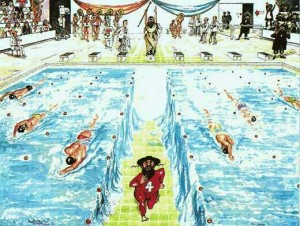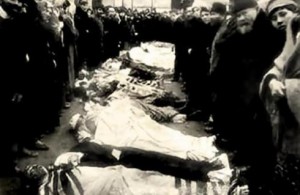Yes, it’s the Jewish Passover season when Jews throughout the world celebrate the escape from Egyptian bondage and the journey to The Promised Land. So, observing the basis of many Jewish holidays: “They tried to kill us. They failed. So, let’s eat.”, feasting is obligatory at the Seder (ceremonial Passover meal) and throughout the holiday. Matzos (a recognition of the unleavened bread the Jews took with them in their haste to leave Egypt) are a Passover staple. HG believes the only good use of matzos is in matzo brei. Simple dish. Matzos are softened in cold water. Then drained and the excess water is gently squeezed out. HG’s Mom added some fried onions to the mix (HG leaves them out). The matzos are added to a bowl of beaten egg. Mixed well. Scoops go into a pan of sizzling butter or canola oil (Mom sometimes used chicken fat). When the bottom of the matzo pancake sets and browns, it is turned over. A dusting of kosher salt and grinds of black pepper. Sour cream or cottage cheese on the side. Jews of Polish extraction usually like things sweet so they have their matzo brei with jam or honey (“Feh!!” exclaims HG). Delightful breakfast whether served sweet or savory. Moroccan Jews make their own version of matzo brei: Solda. Chopped onions are sizzled in olive oil. When transparent, chopped tomatoes are added with salt, pepper, turmeric, smoked paprika and cayenne. Water is added to the sauce and when boiling, broken up matzos are added to the sauce. Simmered until the matzos absorb the sauce. HG serves this with Greek yogurt flavored with a bit of olive oil and pinches of cumin, sumac and zaatar. Plus lemon juice. Top the solda with some fried or poached eggs. Green salad on the side and you have a festive dinner.
Matzos
April 10th, 2018 § 0 comments § permalink
They Tried To Kill Us. They Failed. So, Let’s Eat A Lot And Get Drunk.
March 23rd, 2013 § 2 comments § permalink
Passover is here. Matzos sit next to Easter Bunnies on supermarket shelves across America. It’s that time of year. Boisterous eating and drinking dominated HG’s family Passover celebration, the Seder, when some 76 years ago much of HG’s family was centered in the Flatbush section of Brooklyn. Though a very young lad then, aged HG still remembers all the details of the raucous family feast. First, a small glass of wine and a tiny plate of food was placed on the table for the prophet Elijah (in the unlikely event that he would manifest himself in Brooklyn). The table was set with the symbolic dishes (these were not eaten) of the Hebrew captivity in Egypt. There was the reading of the Hagaddah, the tale of Passover (In those long ago days, the Hagaddahs were published by the Maxwell House Coffee Company. They were distributed, free of charge, at Jewish “appetizing” stores and kosher butchers. A canny PR move by the coffee merchants). A matzo (the traditional unleavened bread obligatory during Passover) was folded into a napkin and “hidden.” This was called the afikomen and when found by the young members of the family each got a monetary award — a shiny half-dollar. (Many years later, HG learned that when the lucky children of one of HG’s real estate mogul public relations clients found the “afikomen” each were rewarded with a $10,000 check). The big moment for little HG was when he was called upon to ask “the four questions” — the inquiry as to why this celebratory Passover night was different from any other night of the year. The small boy relished the spotlight and asked the questions — spoken in English and chanted in Hebrew — with many bravura, theatrical flourishes. “A regular Thomashefsky!!,” HG’s uncle exclaimed, approvingly. (Boris Thomashefsky was a flamboyant star of the Yiddish stage. The conductor Michael Tilson-Thomas — who shortened the name — is his direct descendant). The serious eating began with copious portions of gefilte fish (a very robust version of the French “quenelle”) with heaps of fiery, freshly grated horseradish. Followed by brisket, copious gravy, roasted carrots and onions plus knaidels — matzo meal dumplings which had a sponge like capacity for soaking up gravy. All of this was accompanied by many glasses of kosher-for-passover Schapiro’s sweet Malaga grape wine (purchased at the Schapiro lower east side winery – now closed). The wine carried a kick so the Seder became louder and more irreverent as the evening progressed. Dessert was a compote of stewed fruit plus special Passover pastries like coconut macaroons. Bottles of Vishniak (cherry brandy) and Slivovitz (plum brandy) appeared and were drunk in abundance. A Seder song, Chad Gadya, a song about the survival of a symbolic kid, was sung and shouted — loudly. More songs. Some secular and even naughty. More brandy drinking. At one memorable Seder, the group was singing: “We love Jesus, yes we do. We love Jesus, yes we do. Hooray for Jesus. Hooray for Jesus. Damn good Jew!!” Two very Irish looking cops appeared at the door. Asked the family to tone things down. Neighbors were complaining. Invited the cops to have a drink They agreed. Big glasses of Slivovitz. HG’s cousin proposed a toast: “To Ireland, a great land.” More Slivovitz and the cops joined in the next toast, shouting with the family, “Next year in Jerusalem.”
Passover: Good and Bad Memories
April 1st, 2012 § 0 comments § permalink
Yes, the great family ritual feast — the Seder — will be celebrated in Jewish and many non-Jewish homes (the Obamas will have a Seder) when Passover comes along this month. Like most great Jewish holidays, Passover and the Seder that goes aong with it exemplifies the theme: “They tried to kill us. They failed. So, let’s eat.”
HG loved the family Seder of his youth. There was gefilte fish (made from scratch by HG’s Mom and served with blazing horse radish hand grated by little HG). Chicken soup with matzo balls (best in the universe). Brisket. Knaidlach (dense matzo meal dumplings that soaked up the lush gravy in the absence of challah or rye bread, forbidden at Passover). Tzimmes (A sweet and tangy carrot stew cooked with honey, ginger and chicken feet. HG was not fond of the chicken feet). Dessert was fruit compote of prunes and apricots plus kosher-for-Passover macaroons. Hot tea served in a glass (HG’s father drank it with a sugar cube clutched in his teeth). Schapiro’s sweet malaga wine was served during the meal along with Horowitz-Margareten matzos (the brand favored by HG’s discerning Mom). Though a life-long Socialist who was skeptical of religion, Hershele Zvi Freimann (HG’s Dad), donned a prayer shawl and yamelkeh (skull cap) for the reading of the Haggadah (Passover prayer book).
The HG family Seder was not a sober affair. There was the aforementioned sweet wine. Little HG was allowed to drink as much of this wine as HG wanted and — foretelling the future — HG wanted a lot! There was also vishniak, a sweet, very potent cherry brandy home brewed by Hershele Tsvi Freimann. HG was allowed only a tiny sip of this fire brew. Best of all, there were the sweet, wrinkled cherries that had been long marinated in the vishniak. HG managed to snare a few of these super-alcoholic goodies which made the little chap a happy and drowsy fellow.
There was a somber note in these festivities. The “blood libel” was very much alive in the Belorussia of HG’s parents youth. The “blood libel” was the claim that Jews killed a Gentile child at Passover because the child’s blood was an essential ingredient in making matzos. This is a claim still being made by some Jihadists, neo-nazis and other rabid Jew haters. HG’s parents both recalled the murderous “blood libel” pogroms in Kishinev, a city in Bessarabia (then part of Rumania). Hundreds of Jews were killed. These dark thoughts were banished from the Seder table by vishniak and the hope that HG, his sister and brother would never experience such horrors.


